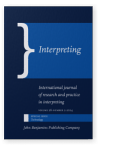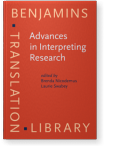Brenda Nicodemus
List of John Benjamins publications for which Brenda Nicodemus plays a role.
Journal
Titles
Signed Language Interpreting and Translation
Edited by Laurie Swabey and Brenda Nicodemus
Special issue of Translation and Interpreting Studies 13:1 (2018) vi, 161 pp.
Subjects Interpreting | Translation Studies
Advances in Interpreting Research: Inquiry in action
Edited by Brenda Nicodemus and Laurie Swabey
[Benjamins Translation Library, 99] 2011. xi, 264 pp.
Subjects Interpreting
2022 The reading habits of professional signed and spoken language interpreters Translation and Interpreting Studies 17:2, pp. 287–312 | Article
Reading is a critical process for conscious learning and enhancing knowledge; however, little is known about reading in interpreters’ professional lives. We used an online survey to collect information about the reading habits of signed language interpreters (n = 1,382) and spoken language… read more
2018 “What’s the sign for nitty gritty ?”: Managing metalinguistic references in ASL-English dialogue interpreting Signed Language Interpreting and Translation, Swabey, Laurie and Brenda Nicodemus (eds.), pp. 49–70 | Article
Humans have the unique capability of using language to talk about language (Jakobson 1957). For example, one can say, “The Italian word for dog is cane.” These metalinguistic references can create a dilemma for interpreters because the critical linguistic term (i.e., cane) must be maintained in… read more
2018 The armature of language Signed Language Interpreting and Translation, Swabey, Laurie and Brenda Nicodemus (eds.), pp. 1–5 | Introduction
2016 “The committee in my head”: Examining self-talk of American Sign Language-English interpreters Translation and Interpreting Studies 11:2, pp. 177–201 | Article
Anecdotally, interpreters report experiencing self-talk before, during, and after assignments; however, this inner dialogue has neither been confirmed nor described in the literature. Prior studies suggest that guided self-talk can boost performance in learning and human performance activities. It… read more
2016 Lexical decisions and related cognitive issues in spoken and signed language interpreting: A case study of Obama’s inaugural address Interpreting 18:1, pp. 34–56 | Article
This study examined omissions, errors, and variability in lexical selection across simultaneous interpretations of President Obama’s 2009 inaugural address, in three spoken languages (French, German, Japanese) and in American Sign Language (ASL). Microanalysis of how information conveyed by 39… read more
2015 Directionality in ASL-English interpreting: Accuracy and articulation quality in L1 and L2 Interpreting 17:2, pp. 145–166 | Article
Among spoken language interpreters, a long-standing question regarding directionality is whether interpretations are better when working into one’s native language (L1) or into one’s ‘active’ non-native language (L2). In contrast to studies that support working into L1, signed language… read more
2011 Bimodal bilingual interpreting in the U.S. healthcare system: A critical linguistic activity in need of investigation Advances in Interpreting Research: Inquiry in action, Nicodemus, Brenda and Laurie Swabey (eds.), pp. 241–260 | Article
Legislation guarantees communication access in the United States healthcare system for deaf citizens and this access is often made possible by bimodal bilingual interpreters, individuals fluent in spoken and signed languages. Yet there is a conspicuous lack of research on interpreted discourse in… read more
2011 Introduction Advances in Interpreting Research: Inquiry in action, Nicodemus, Brenda and Laurie Swabey (eds.), pp. 1–4 | Introduction
2010 Review of Stone (2009): Toward a Deaf Translation Norm Sign Language & Linguistics 13:1, pp. 75–81 | Review









